Choosing the Right E-commerce Business Model to Sell Your Product
As retail continues to shift online, businesses and manufacturers are faced with ever-growing pressures to build serious online presences and distribution. This article looks at the different options available, and assesses their merits and considerations from a financial standpoint
As retail continues to shift online, businesses and manufacturers are faced with ever-growing pressures to build serious online presences and distribution. This article looks at the different options available, and assesses their merits and considerations from a financial standpoint
Martin works with large, PE-owned and quoted companies, as well as startups. He is particularly strong in growing top line and margins.
PREVIOUSLY AT

The shift from offline/brick-and-mortar retail to online eCommerce is a trend that has garnered attention and commentary for much of the last two decades. What was once a niche market focused on selling a few select products and services has ballooned into a nearly $2 trillion industry whose influences dominate the retail industry in more ways than ever before.
Despite the noise, penetration of overall retail sales continues to be in the sub-10% range, particularly outside of the US. Calls for a radical transformation in the retail industry so far have largely not been borne out, and offline retailers have over the last 10-15 years continued to do well. In fact, the list of the world’s largest retailers continues to be dominated by offline retailers, or retailers who were born offline and continue to derive most of their sales from physical retail locations.
However, while evolve-or-die style calls for strategic shifts to eCommerce may have in the past been overblown, recent data and news suggests that this issue is perhaps more pertinent than ever before. A recent article in the New York Times for instance highlighted that “store closures […] are on pace this year to eclipse the number of stores that closed in the depths of the Great Recession of 2008.” Similarly, retailers are going bankrupt at record rates, and “in a little over three months, fourteen chains have announced they will seek court protection […] almost surpassing all of 2016.”

Online shopping has moved to the top spot among the drivers of this change. As Credit Suisse’s Christian Buss points out, “Today, convenience is sitting at home in your underwear on your phone or iPad. The types of trips you’ll take to the mall and the number of trips you’ll take are going to be different.” And the data bears this out. Whilst offline store closures accelerate, eCommerce continues to grow at a steady and accelerating pace. In fact, “between 2010 and 2014, eCommerce grew by an average of $30 billion annually. Over the past three years, average annual growth has increased to $40 billion.”
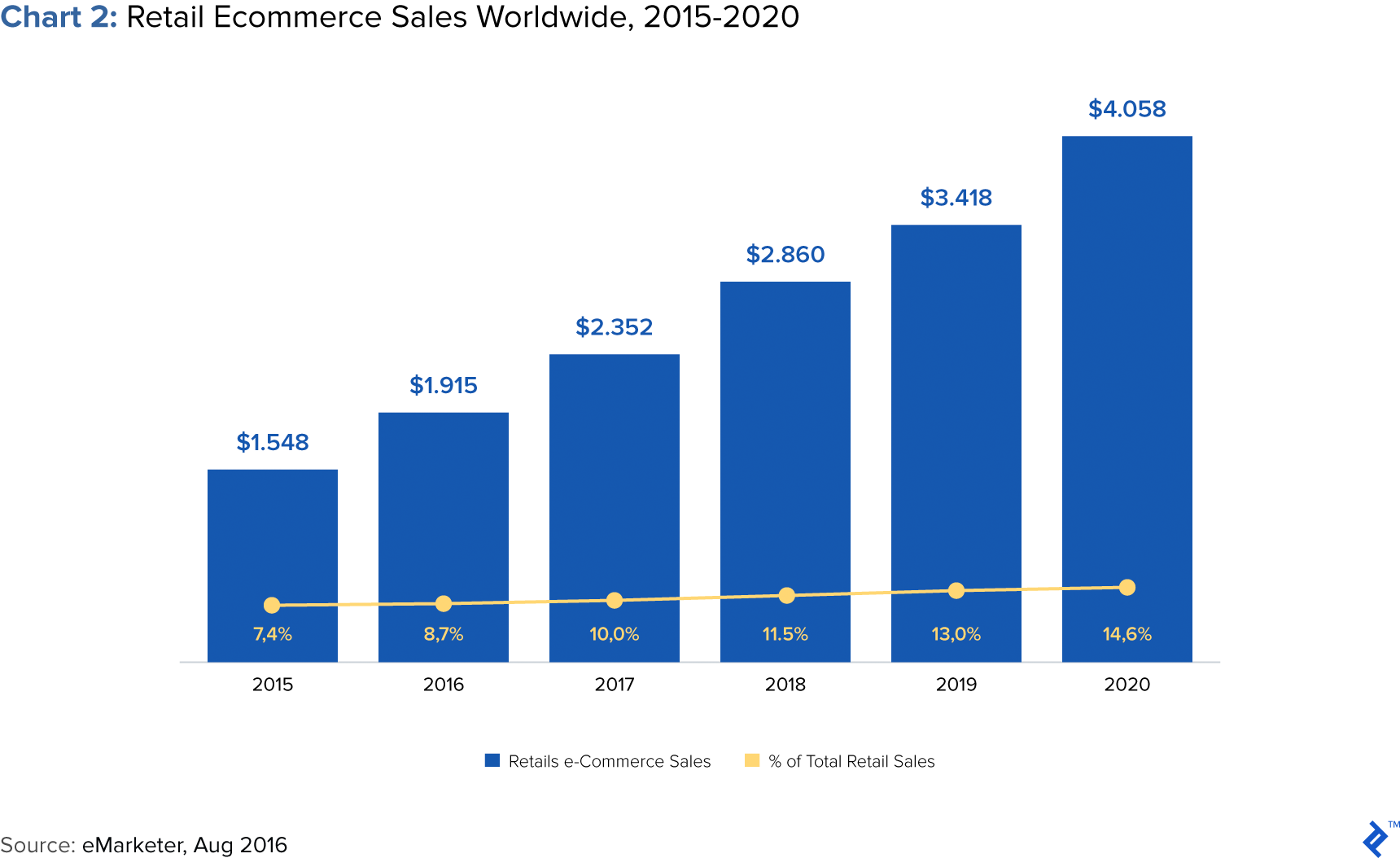
All evidence points to this trend continuing. Oliver Chen, an analyst at Cowen & Co., claims that “while high-end malls continue to perform well, the exodus away from brick-and-mortar stores is taking a toll on so-called C- and D-class shopping centers […] There are roughly 1,200 malls in the U.S., and those classes represent about 30 percent of the total.”
With the above in mind, retailers—or product manufacturers looking for retail distribution—are looking more than ever before to establish meaningful online distribution channels. Perhaps the best example of this emerged in recent days, when Petsmart announced its acquisition of Chewy, a relatively unknown petcare eCommerce company, for $3.3 billion, making it the largest acquisition of an eCommerce retailer ever.
I recently worked with a client who was facing this dilemma. The client is a manufacturer that sells its products through a number of retail channels, with a large proportion of its sales dominated by one of the top brick-and-mortar retail names in the US. It operates in a market that had been slow to migrate to eCommerce at any significant volume, but now appeared poised to do so at an explosive rate, with venture capitalists funding ambitious new startups and Amazon growing its range in the category. My client was anxious not to get left behind.
This article aims to highlight how businesses considering a shift to selling online should be thinking about their options, primarily from a financial standpoint. Drawing upon the example of my client, I run through the various options and the financial implications each option is faced with. The article is written primarily with producers/manufacturers in mind. If you manufacture a product, and want to sell it online, this article is for you.
The Options
At a high level, there are basically four different options for selling online, and these were the options we evaluated for our client.
Option 1: Direct-to-Consumer
Direct-to-Consumer (DTC) is probably the more commonly known type of eCommerce model. As the name implies, DTC involves selling directly to the end customer, through your own website, thus bypassing any middlemen that would normally enter the retail chain.
In a DTC model, the business in question would establish the website, generate traffic to the site, and have full control over pricing and positioning, enabling them to sell to the customer without having a retailer take a margin. The model is displayed graphically in Figure 1 below.
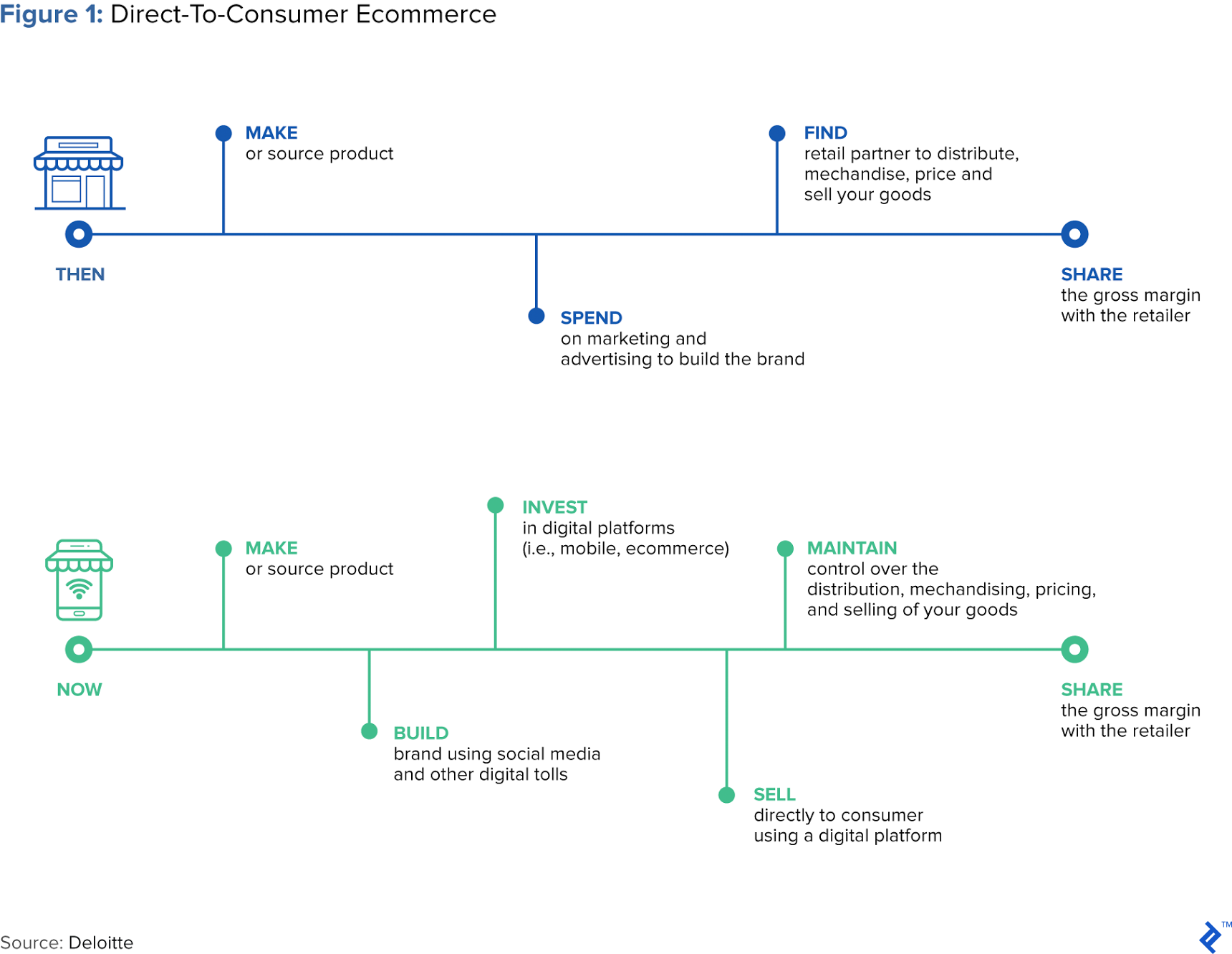
The DTC model has in recent years been gaining ever more traction amongst product manufacturers and service providers. Household consumer brands such as Nike and L’Oreal are using “‘portable’ eCommerce experiences, mobile apps with in-store beacons, and digital out-of-home digital media networks to extend the engagement started on eCommerce websites into the store and deliver an expanded choice of personalized offerings at the point of sale.”
Option 2: Selling as a Private Label Supplier
Another option would be to sell the product private label to a third party who is either already online or moving online. Shopify provides a nice definition of what private label means:
A private label product is manufactured by a contract or third-party manufacturer and sold under a retailer’s brand name. [The] retailer […] specif[ies] everything about the product—what goes in it, how it’s packaged, what the label looks like […] This is in contrast to buying products from other companies with their brand names on them.
This is the simplest option of the four, since it involves no brand building or marketing efforts. All of these are taken care of by the retailer. In fact, depending on the agreement with the retailer, many of the product specifications might themselves be set by the retailer.
Private label is a very successful strategy in many industries, particularly food and beverage. Euromonitor for instance points out that “US fresh milk […] was the largest private label market globally in 2014. With value sales of USD $14.5 billion, it is a large market, and private label accounted for 67% of total sales, or USD $9.7 billion.” Many retailers sell private label products, for instance Walmart’s Great Value brand, or Costco’s Kirkland Signature products.
Option 3: Selling Wholesale to a Retailer
A third option would be to sell one’s product wholesale to a third-party retailer who is already online. This is very analogous to how things are done in the brick-and-mortar space and would probably involve much of the same unit economics for both parties.
In this option, all the marketing and distribution would be taken care of by the retailer, whereas the branding would be the responsibility of the producer. Final retail pricing would also be established by the retailer, but clearly influenced by the wholesale price that the manufacturer charges. Contrary to the private label option, the manufacturer has most of the control over the product specifications and design (although of course, large retail companies may influence these to a certain extent if they hold strong power of the supplier’s sales).
The most famous third-party retailer in eCommerce is of course Amazon. Selling to Amazon at wholesale, in the same way as you would sell to a traditional brick-and-mortar retailer, would mean letting Amazon take care of how many units they could sell to consumers at their retail price.
Option 4: Selling on an eCommerce “Marketplace”
The final option involves selling an an eCommerce marketplace. An online marketplace is a website which puts buyers and sellers together and acts as the platform through which these two parties transact. The Balance provides a nice definition of this:
Unlike conventional eCommerce websites, marketplaces transfer the burden of maintaining inventories, logistics, images, product descriptions, and pricing to the seller. There is more than one operational model for marketplaces, but the most common method involves marketplaces being merely an order booking mechanism.
Marketplaces display the seller’s wares, collect orders and payments, forward orders to the seller, track delivery, and release payment to the seller after deducting a fee.
Perhaps one of the most famous marketplaces is eBay. Founded in 1995 as an online auction website, eBay became one of the biggest and earliest marketplace successes in the eCommerce space. Today, there are many marketplaces, including Amazon which operates a dual eCommerce model of “vanilla eCommerce” as well as a marketplace model.
Summary
To summarize, the four options above vary primarily in the amount of responsibility shared between the producer and the retailer in marketing, branding, and distribution. The table below summarizes the options.
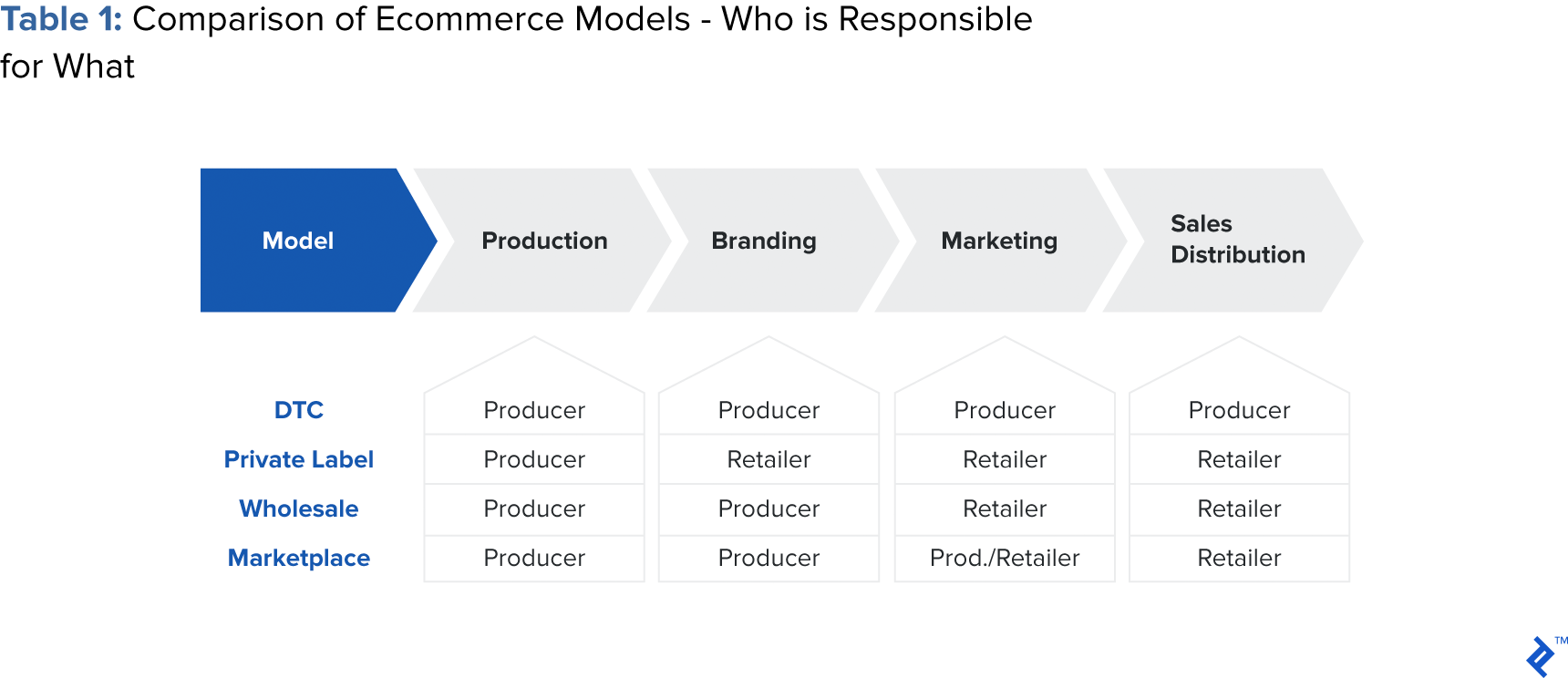
Financial Evaluation of the Options
There are pros and cons to each of these options, and the relative merit of each option depends on a number of factors, such as appetite for risk, ability to absorb early losses for long-term gains, and ability to invest in your brand upfront, which depends on access to capital.
Fundamentally though, all options come down to a tradeoff between the following two factors:
- The EBITDA and margin assumptions and implications of each option
- The volume and growth assumptions and implications of each option
The analysis below runs through the unit economics of each scenario, using my client as a case study for the analysis.
Benchmark: The Traditional Business
Let’s start by looking at the way my client traditionally sells its product to retailers. For sake of our analysis and simplicity, let’s refer to my client as “Manufacturer, Inc.” Obviously, the retailer makes a margin, selling the product to the consumer for more than it pays to Manufacturer, Inc. The principal retailer that my Manufacturer, Inc. deals with is a low-margin, high-volume player so that margin is smaller than you might see in many places.
The other thing worth noting is that this is a business with a fairly high return rate, at 24%.
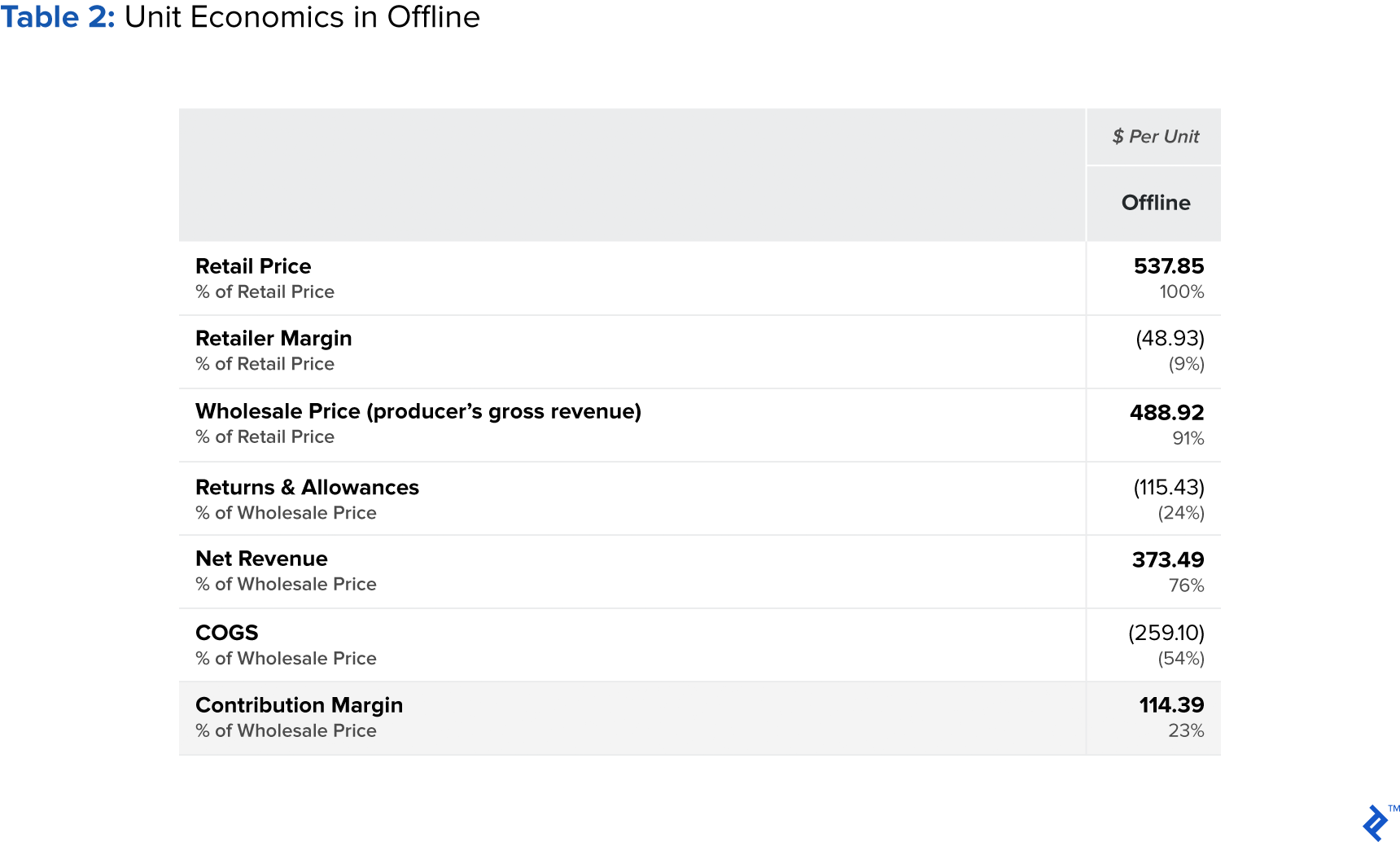
Option 1: Direct-to-Consumer (DTC)
Under this model, Manufacturer, Inc. would establish its own website and attempt to drive all its own traffic to that website. It would keep the entire retail price of the product sold. Let’s look at how this affects the unit economics.
Price
There are two elements to this. First, the retail price and the wholesale price are the same. This is the primary benefit of selling DTC. Second, and potentially more important, the producer gets to determine its own pricing and positioning strategy without having to adhere to the retailer’s strategy.
In the case of Manufacturer, Inc., they had a high-quality product that had won lots of praise from consumer magazines, but the retailer was positioning it only to price-conscious consumers. Our market analysis showed “white space” for the quality-conscious young professionals now shopping online. For that reason, we built into our assumptions the strategy of going after the higher end of the market (and therefore a higher retail price).
Unit Production Costs
Overall unit COGS would be about the same as the offline business, but what would change materially would be the retail price (given that we were targeting a higher price segment). Add to that the fact that returns, according to our research, tended to be lower online, and you can see how DTC starts to look very attractive. Manufacturer, Inc. would now be responsible for shipping (whereas in the offline model the retailer picks the product up and ships it to the end consumer), and would have to process credit card fees. But contribution margin still looks attractive.

Marketing
But if it were so easy, why was Manufacturer, Inc. not selling DTC before now? Or why did they not open their own retail store rather than giving all that margin away? Simply because, as a manufacturer, they did not know how to open a shop and get people into it. That’s what the retail channel partner brought to the table. When selling DTC online, you have to recreate this yourself.
At a high level, there are essentially three types of marketing efforts one can embark on in eCommerce. The following breakdown is an oversimplification of a very complex and multifaceted field, but serves the purpose of illustrating the general approaches one can take:
- Paid online advertising: Often referred to as PPC advertising (pay-per-click), this is one of the most commonly used marketing strategies that online retailers employ. There are many types of PPC advertising, and many channels through which you can do it. Some of the more commonly known channels are Google AdWords, Facebook advertising, display advertising, retargeting/remarketing, and video-paid ads such as YouTube advertising. All of these have their specific implications, but generally all share the common factor that the cost of the ads are on a per click (or sometimes per impression) basis.
- Organic online advertising: This refers to advertising that is performed through online channels, but where there is no cost associated with impressions or clicks. An example would be social media marketing, where the business in question must build a social media presence, engage an audience, and drive traffic to their site in this manner. Other examples would be blogging and content creation. Finally, one could argue that Search Engine Optimization falls into this category as well.
- Traditional brand building: A third type of marketing effort would be traditional marketing aimed at creating brand awareness and loyalty. This could be done either through online channels or through traditional offline channels such as print advertising, television, radio, or billboards. The distinguishing feature here is that these efforts are not aimed at creating direct traffic and referrals to the business’ site, but are aimed at creating brand awareness, and therefore indirect traffic and referrals.
Whatever channel or strategy each business decides upon, the key point is that, in a DTC model, the producer would need to take control of this function. This means that the producer would take on the associated expense, both in terms of direct marketing expense and in terms of indirect expenses such as the cost of labor associated with the marketing efforts.
In the example of Manufacturer, Inc., we determined that PPC advertising would be our primary source of marketing. As such, in order to perform a proper financial evaluation of the options, we had to estimate what the marketing expense would amount to. Below, I run through the analysis we did on this.
We could write an entire separate article on the click economics of this business, but essentially, the cost of each customer is as follows:
For Manufacturer, Inc., the search words that would trigger the ad appearing, along with clicks related to those words, cost $5.50 per click at the time of our research. But the cost of each paid customer acquisition is much higher than this. Only some of the customers who click through will actually buy anything. If your conversion rate is 20%, you need five clicks to get one sale.
Paid customer acquisitions obviously will not be all of your traffic. If 20% of your customers find you for free, then you only have to pay the above amount for 80% of customers, and for the rest you pay zero directly. So, more generally:
For Manufacturer, Inc., the conversion rate benchmark that we found in the industry was 1%, meaning that they would pay $5.50 per click for 100 browsers in order to get one sale, making $550 per paid acquisition. With a relatively unknown brand, we only forecast about 20% free traffic, so they would be paying that $550 on 80% of their customers. Overall then, that’s $440 in paid clicks per customer acquisition.
We also forecast that 1% of customers would refer a customer, for a cost of $150 paid to the referrer, adding 1% of $150 = $1.50, to make a total direct marketing cost of $441.50 per unit.
Remember that this is just to get customers. In the offline world, the retail channel takes care of this, in return for that relatively small retailer margin.

As one can see, once marketing costs are factored into the picture, the unit economics analysis swings heavily in the other direction. So, given the above, why would anyone want to sell online?
The more eCommerce savvy among you will have noted that nobody does if their cost per acquisition is going to remain at 58% of the selling price. As you build your brand, your conversion rate goes up, and your percentage of free traffic also goes up. You also presumably get better at online marketing and therefore optimize your per-click economics. By exactly how much depends on how successful you are at your online brand-building and paid advertising optimization—all the capabilities that established offline businesses typically have little competitive advantage in.
In our case, we assumed that by buying in the right expertise, we could get the conversion rate up to 3% and the free traffic up to 40% in five years. With more sales also coming in from referrals rather than clicks, the cost per customer acquisition would fall to a more acceptable level.
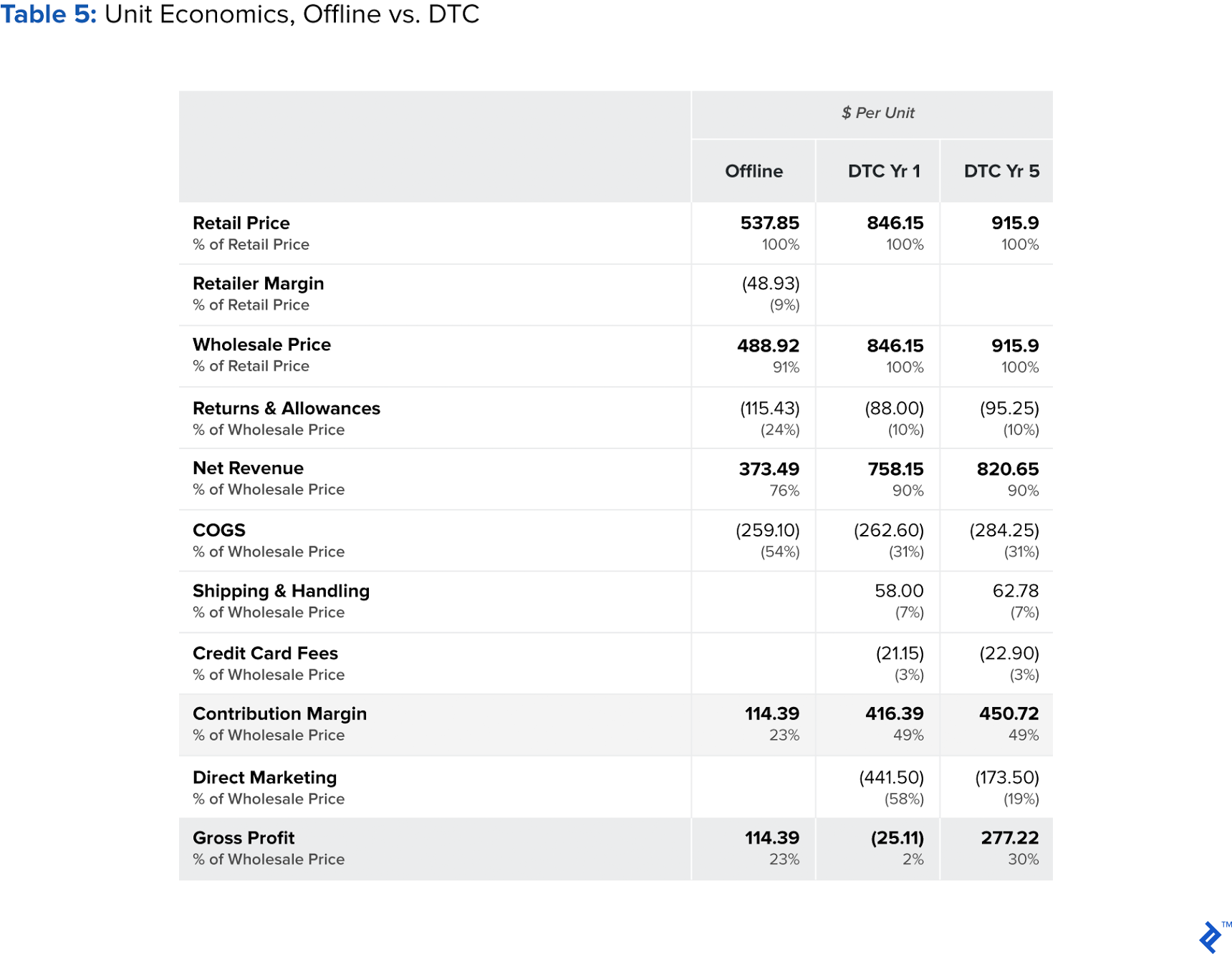
You can probably already see, though, how sensitive your profitability is to the cost of bringing customers through your virtual door. In fact, that’s not the end of it, because the way in which you bring your direct marketing cost down has a lot to do with your brand building. “Free” traffic is not really free: You have to pay your social media manager, pay-per-view ads on Youtube and Facebook, and content to be created. The cost of this roughly stays the same in raw dollars, which means it does go down per unit if—but only if—it results in you selling more units.
So let’s bring that into the mix. In the case of Manufacturer, Inc., we estimated about $2.1 million to $2.3 million each year in brand building (“indirect marketing”) spend to achieve the unit sales below.
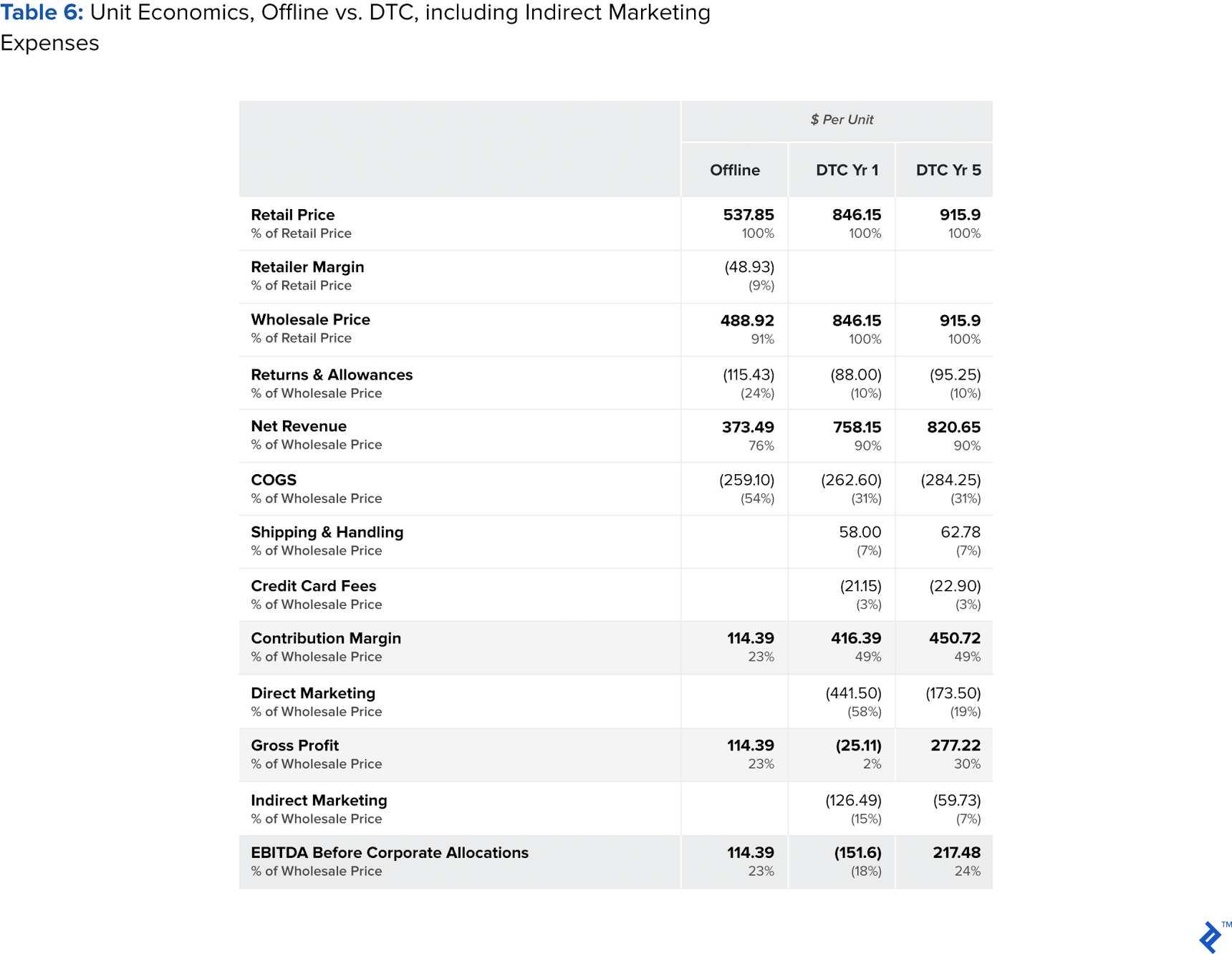
In summary, the DTC model is highly sensitive to marketing costs. To get your free traffic and conversion rate up, a lot of capital is required to invest in brand building and in absorbing the initial losses. The rewards, however, can be significant.
Let’s see how the other models compare.
Option 2: Private Label
This option is actually incredibly simple and low-risk. You can supply your product to a brand that is already online and have them sell it under their own brand name. Your profitability is not at all affected by the cost of marketing, because the private label partner takes care of it. However, as a result of this, the retailer takes a larger margin than would an offline retailer selling your branded product. They keep the upside as the marketing costs fall over time. But your investment in upfront brand building is zero.
In this model, we assumed a similar but slightly less high-end positioning to the DTC option.
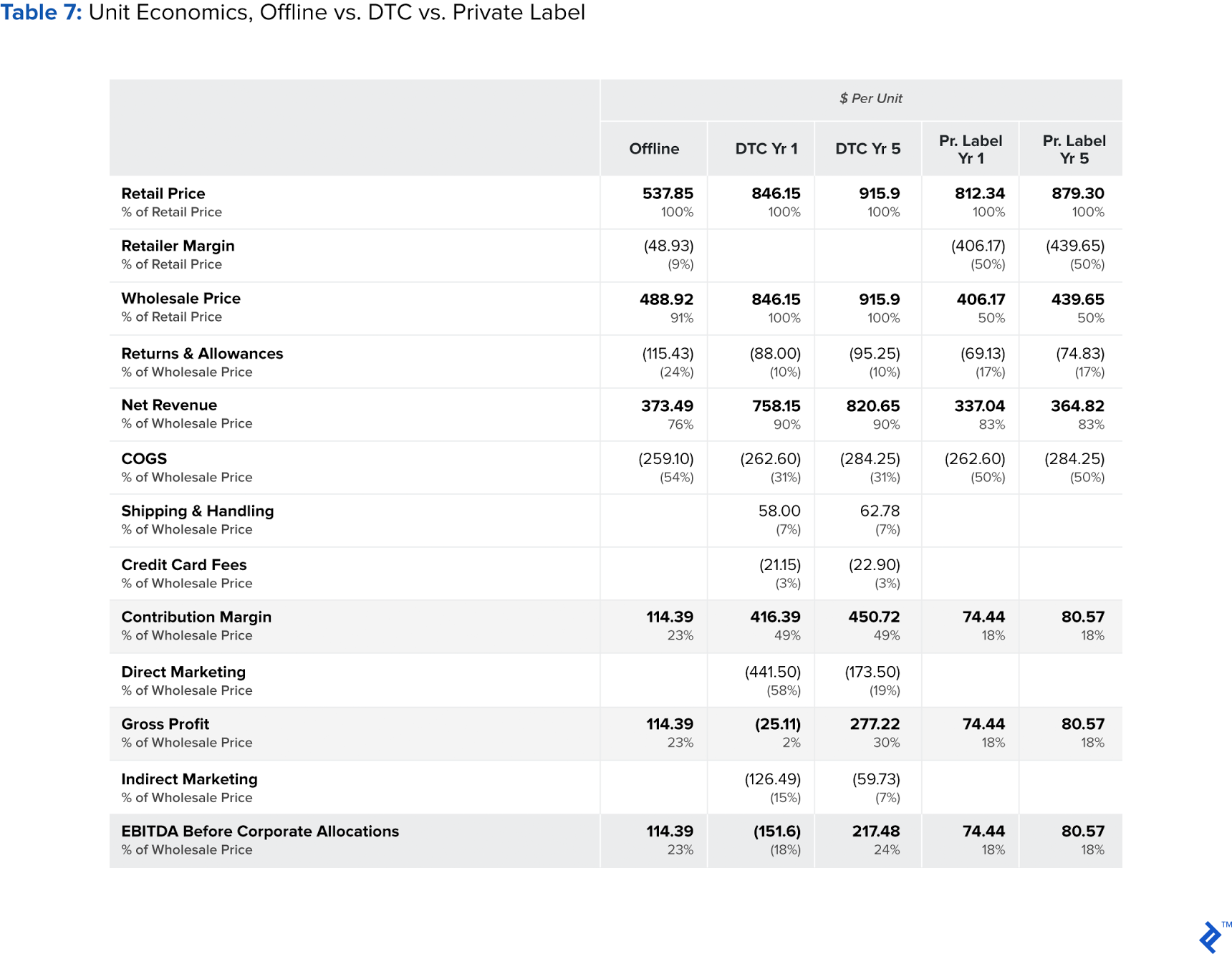
Compared to the DTC option, the private label option has both a clear advantage and a disadvantage. If a company does not have capital to commit to building a brand, then private label is an excellent way to participate in a market profitably from the outset. Even for those who may have capital but are concerned about the risks of a DTC model, private label avoids the downside risk of spending significant capital on brand building that may or may not be successful. However, for those with capital that they are looking to invest in maximizing their profits from the growth of eCommerce in a particular sector, private label offers limited upside. The gross margin must still be shared with a private label partner, whereas in the DTC model, once brand recognition has grown and marketing is a lower percentage of the selling price, the margin increment from cutting out a distribution or retail partner can be significant.
Options 3 and 4: Selling to—or Through—Amazon
After evaluating the private label option, we can see the benefits of selling to a company that is already in the market place. So why not sell to the company that virtually owns eCommerce? Amazon. There are actually two ways to do this. You can sell your product to Amazon itself, who then sells it on its website for a profit. Or, you can be a seller on the Amazon marketplace, selling your own products and keeping the whole price minus 15% referral fee, but Amazon will not promote you.
There are pros and cons to each model. Let’s start with the positioning and the price: Unlike in the DTC model, you are now beholden again to a retail channel relationship. We could not create a brand with a price premium here. In fact, we found that Amazon’s customer mix and strategy biased us toward a lower end product. And, of course, Amazon would still take a margin. They also charge a “co-op” fee for promoting your product. If you sell to Amazon, they take care of shipping to the customer; if you sell through Amazon marketplace, you pay Amazon’s fulfillment team to take care of it.
The major advantage of Amazon, of course, is its captive market and, in this category, its significant forecasted future growth. There are two major advantages to this: first, volume—this brings sales revenue up and also brings the per unit impact of the indirect marketing spend down; second, the lack of direct marketing costs—so many customers are already on Amazon.
In the model in which we sell to Amazon, we eliminated paid clicks altogether. We ramped up brand building spend to between $3.7 million and $3.9 million each year so that people finding Manufacturer, Inc. on Amazon could Google its name and find something interesting, and so that we could direct traffic from across the web to our Amazon page, but paying for clicks was not necessary. Furthermore, Amazon offers the opportunity to build up a base of customer reviews, which, in our model, was also a significant contributor to growth of our share of the Amazon market (which is itself growing).

In our model, the storefront (marketplace) option turned out be the least attractive. Because Amazon gives less prominence to marketplace sellers than it does to its own products, we felt that we would have to resort to paid clicks to get comparable volumes—not to the same extent as in a DTC model, but still to some extent. Furthermore, Amazon’s customer mix meant that we could not justify the price points that we were assuming in the DTC model, while the referral and coop fees chipped away at the advantages of a typical direct-selling model and we still retained the shipping and credit card fees.
Conclusion
In our particular model, selling to Amazon proved to provide the optimal combination of risk and return. It was certainly not the lowest risk option: That was the private label option, which required no upfront investment and was EBITDA-positive from the beginning. However, selling to Amazon had the largest upside without having the deep “hockey stick” beginning that the DTC model had. The summary of our analysis is shown graphically in Table 9 below:
Table 9: Summary Scorecard of Options
| Option | Investment Horizon | Alignment with Existing Operational Capabilities | Margin Potential | Growth Potential |
|---|---|---|---|---|
| Direct-to-Consumer | Long | Low | High | Medium |
| Private Label | Short | High | Low | Medium |
| Amazon Wholesale | Long | Medium | High | High |
| Amazon Marketplace | Long | Medium | Medium | Medium |
This could easily change, though. One benefit of selling on Amazon is the ability to build a brand, particularly through the reviews that customers write on Amazon. A future DTC venture for this client would hence not be a “standing start” and the cost of each customer acquisition need not be so prohibitive.
Whatever one’s choice, it’s clear that a move into an eCommerce channel is perhaps more relevant than it ever was. Well-known household brands are closing stores at record paces: Sears and Kmart recently announced the closure of over 150 stores, Bebe is closing 180 stores, JCPenney is closing 138 stores, Macy’s is closing 68 stores, and the list just keeps getting longer. But if the cautionary tales don’t sway you, perhaps the more encouraging ones will. An interesting post on the subject from HBR delves into the Nordstrom story, which is illuminating:
For nearly 100 years, Nordstrom’s purpose has been to provide a fabulous customer experience by empowering customers and the employees who serve them. To fulfill this purpose, as far back as the late 1990s, Nordstrom started looking for opportunities to invest in technologies that would further empower their famously empowered employees. These investments included Nordstrom.com and a perpetual inventory system that allowed Nordstrom to offer a consistent multi-channel experience by 2002.
Then, between 2004 and 2014, Nordstrom made an extraordinary series of investments…First came a new point-of-sale system […] This was followed in quick succession by the launch of an innovation lab, the creation of Nordstrom apps, the introduction of popular social apps that created buzz as well as mobile checkout, support for salespeople texting, and ultimately the acquisition of a cloud-based men’s personalized clothing service.
Because Nordstrom.com and the Nordstrom app are integrated with the inventory management system, customers can find what they want in one place and have it delivered from somewhere else to a third place. Nordstrom’s engagement with popular social apps, like Pinterest, extends what Nordstrom’s employees know about their customers’ preferences. Items popular on Pinterest are tagged with a red tag bearing the Pinterest logo and prominently displayed in the store, linking their online and offline worlds. Their employees, famous for providing customer service, are now armed with information not only about what a customer has bought in the past, but what they like, and even what they shopped for but could not find. Mobile checkout makes it easier than ever for any employee to see a customer through the payment process and thank them, rather than sending them to a cash register[.]
The persistent digitization of Nordstrom’s business has allowed the company to grow revenues by more than 50% in the last five years. The company is growing sales in both full-price and off-price businesses through both online and traditional channels.
The willingness and commitment by retailers and producers to move online may ultimately decide whether one is found in the increasingly crowded offline retailer graveyard or successfully adapts to go the Nordstrom route.
Understanding the basics
What does an eCommerce company do?
An e-commerce company facilitates the buying and selling of goods/services over the internet, and via electronic payment methods. There are four types of e-commerce models: (1) Direct-to-Consumer (B2C), Business-to-Business (B2B), (3) Consumer-to-Business, and (4) Consumer-to-Consumer (Marketplaces).
What are the different models of e-commerce?
There are four e-commerce models: (1) Direct-to-Consumer (B2C), where companies sell to consumers; Business-to-Business (B2B), where businesses transact with each other; (3) Consumer-to-Business, where consumers sell to businesses; and (4) Consumer-to-Consumer, i.e. auction sites and marketplaces.
Do you need a business license to start an online store?
Yes. All companies require a business license to transact including online stores and e-commerce companies. In some jurisdictions, one may not need a license until one reaches a revenue threshold. To navigate these nuances, visit U.S. Small Business Administration’s (SBA) online resources.
About the author
Martin works with large, PE-owned and quoted companies, as well as startups. He is particularly strong in growing top line and margins.
PREVIOUSLY AT


